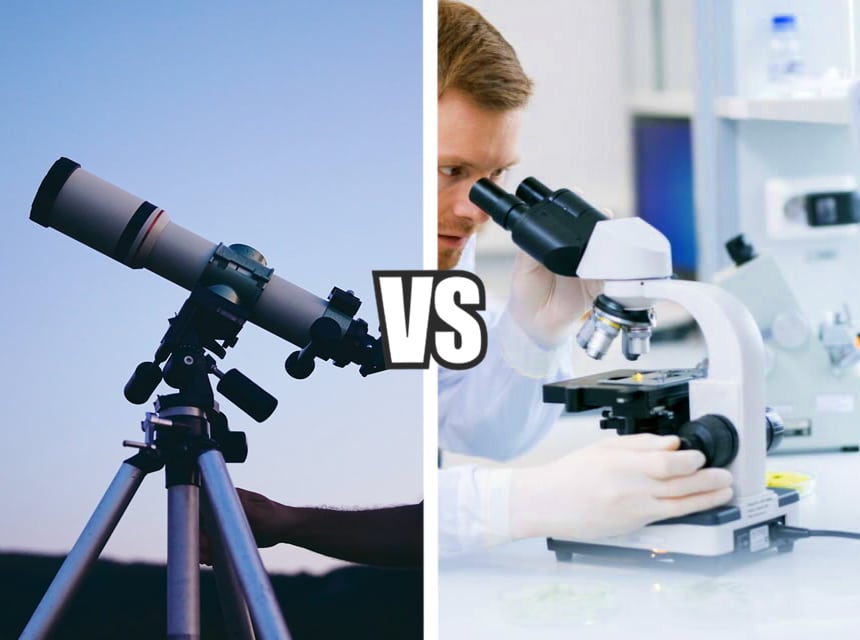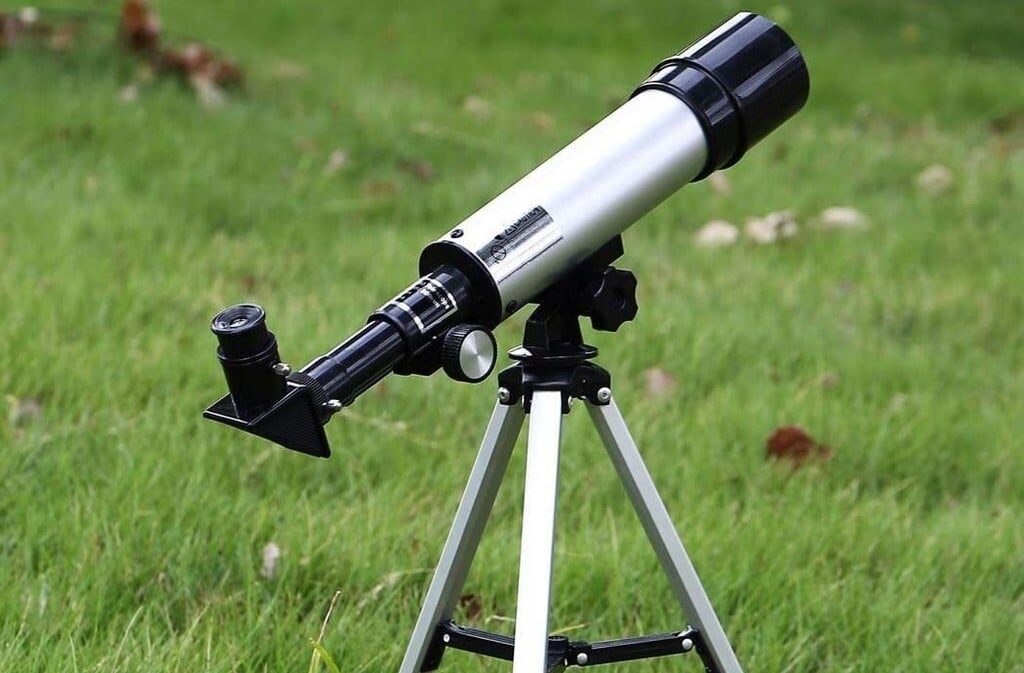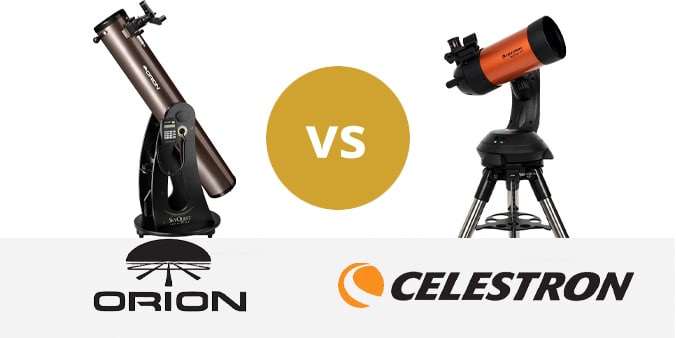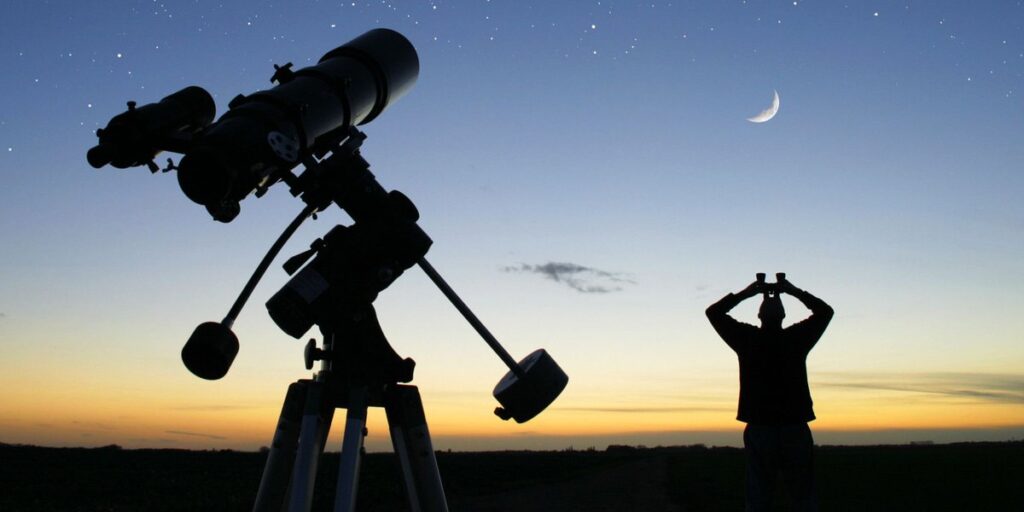

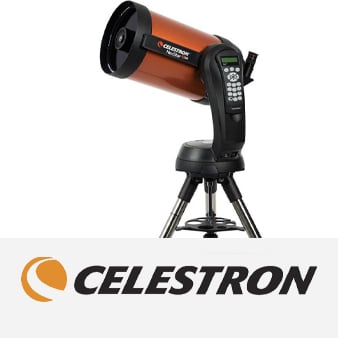
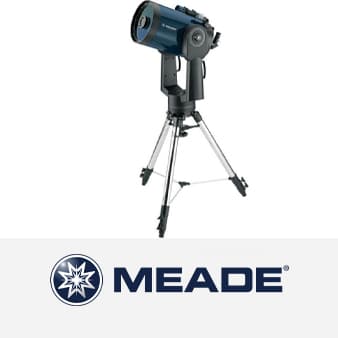
You can’t discuss telescopes without comparing Celestron vs Meade, the two prominent brands that have dominated the market. Why is this? Apart from being established in the industry and making innovative products for a long time, they both provide a wide range of telescopes ranging from entry level to advanced models. Their telescopes include top-notch optics, GPS and GoTo technology, among other features. We have evaluated the products and their manufacture, warranty and the field of applications when comparing the two types of telescopes.
To help you choose the better option in different scenarios, we examined essential features such as their objective lens, focal length and ratio, viewfinder, and their level of magnification. These features determine the extent of their scope, the quality of image they generate, and when you should choose one over the other. We also looked at the cost, included accessories, and the size and weight of Celestron vs Meade telescopes when reviewing them.
We will start with a brief comparison of the two telescopes and the best time to use them. We will also provide an overview of the cost, manufacturing and warranty of each brand to equip you with some basic information before you can make your purchase. We have a comprehensive review of their individual features in the next section of this guide.
When it comes to warranty, Celestron wins hands down. While Meade offers a limited warranty of one year, Celestron products come with a 2-year limited warranty, and the optical system is covered by a limited lifetime warranty which increases confidence in the products among buyers.
Celestron is based in Torrance, California. It is a leading manufacturer and distributer of telescopes, spotting scopes, microscopes and binoculars. Celestron has been making telescopes since 1960. After Tom Johnson received a positive response to the Cassegrain reflector he had built, he came up with a Schmidt-Cassegrain (SCT) design which implements reflector and refractor properties. The 8-inch C8 with a bright orange tube was the first popular product which the Company made in 1970. They have since created many inventions and innovative products.
Meade Instruments is more recent. It was established in 1972 and it has headquarters in Irvine, California. It is the largest telescope manufacturer in the world and a prominent rival of Celestron. The Company makes and distributes spotting scopes, microscopes, binoculars, and CCD cameras.
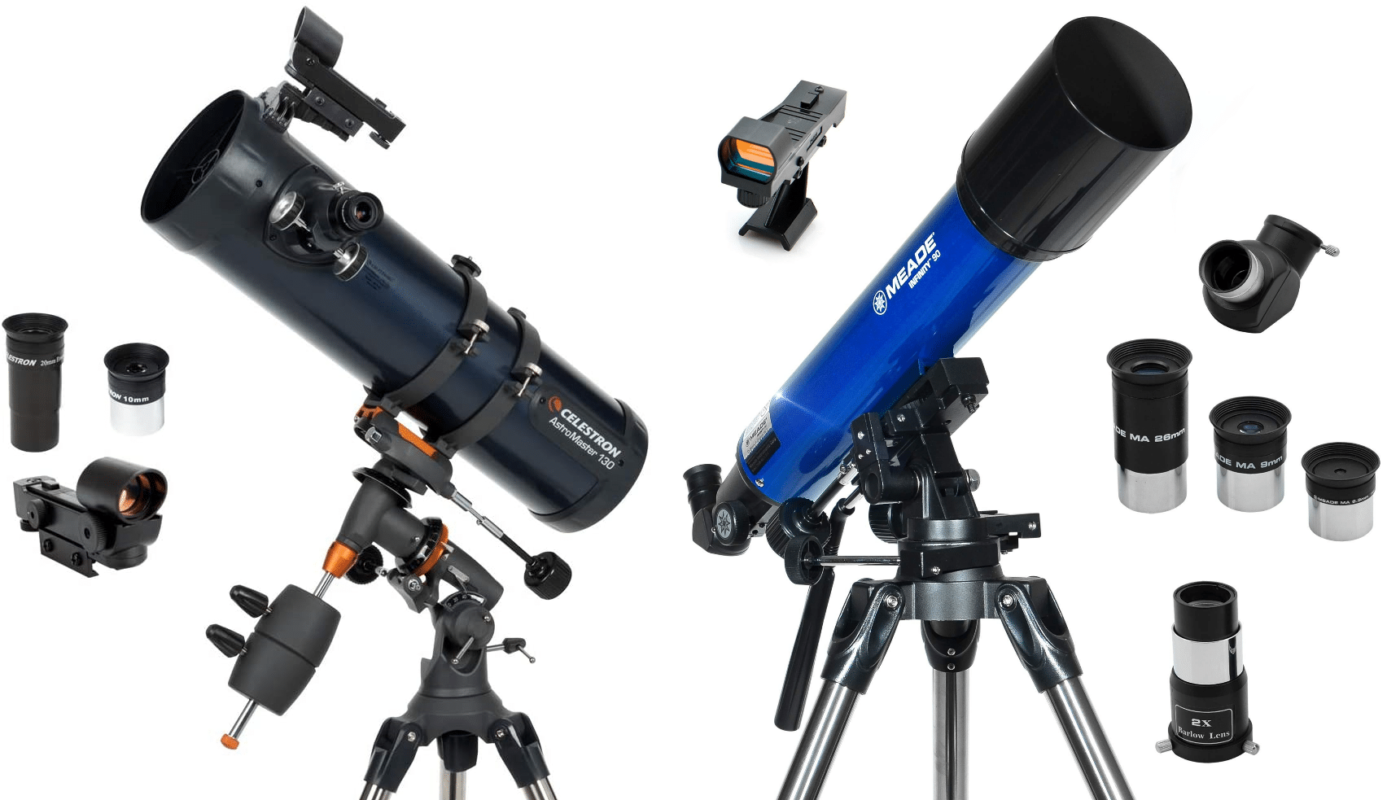
If you look at the paragraph above this, you will notice that Meade and Celestron make similar products for users of all levels. However, the technology obviously varies and the two brands have come to be easily identified by the type of technology they utilize in their products. For example, Celestron products incorporate Schmidt-Cassegrain (SCT) optical system which includes a magnifying secondary mirror that allows the tube length to be shortened by 5x to produce the high optics of a large diameter while maintaining shorter focal length. Meade telescopes are known for their patented Ultra-High Transmission Coatings and dual fork mounts, among other common features.
It is true that the two brands cater to telescope users of all levels, but there are slight differences. Both Celestron and Meade offer a lot of options for beginners. You can easily find an entry-level model in the market for under $100. Celestron has particularly devoted itself to this niche which has made it among the most known and bought telescope brands. Celestron also fairs well in the mid-range category because it has an extensive database of more than 40,000 celestial objects, SkyAlign functionality and GoTo technology, compared to Meade which has a smaller database and takes more effort to set up. The mid-range class which accommodates a lot of users of all levels is where you will also find most of Meade’s telescopes. Things change when it comes to the advanced telescopes for professionals where Meade dominates the niche; Meade brand is the preferred choice for its high-end features in premium models and the extensive AutoStar II database system of 145,000 celestial objects.
More often than not, Meade would be more expensive if you are comparing Meade vs Celestron telescope that are considered to have similar features. This is because the latter has focused more on affordable entry-level models. Otherwise, there isn’t much difference in the pricing of Meade vs Celestron telescopes in the mid-range and high-range categories. Both companies have starter models for as low as $50, intermediate models for hobbyists and general observers that cost $1000 and above, and premium telescopes for experienced astronomers that could cost more than $10,000. We have provided examples of the three major categories while comparing the two brands. We are sure you will find our guide informative in helping you choose a telescope that fits your budget and your skill level. As is usual, the price is mainly determined by the power, features and accessories of the telescope.
| Meade LX90 | Celestron 8SE | |
| Level | Intermediate | Intermediate |
| Type | Computerized | Computerized |
| Magnification | 90x | 81.28x |
| Focal length | 2500 mm | 2032 mm |
| Focal ratio | 10 | 10.01 |
| Objective aperture | 254 mm | 203 mm |
| Lens diameter | 25 mm | 25 mm |
| Viewfinder | 8x50mm | 8x50mm |
| Weight | 50 lbs | 49 lbs |
| Warranty | 1-year limited | 2-year limited |
| VIEW ON OPTICS PLANET | VIEW ON OPTICS PLANET |
When debating between Meade LX90 vs Celestron 8SE, most buyers believe that the Celestron 8SE, which has been upgraded with 78% greater capacity to gather light, is superior in optics and mechanical components, but is this the case? Below is an in-depth analysis of these two models that are popular with intermediate users. We have discussed features such as magnification, focal length, aperture, objective lens diameter, and focal ratio, which all affect the quality of the image. They will help you to understand when it would be better to choose one telescope over the other.
The OTA (optical tube assembly) is the main body of a telescope that holds the eyepiece and other optical accessories. It is also the part that collects light. In a Celestron 8SE, you can easily detach this part from the mount because it is connected by a regular vixen dovetail, and also detach the GoTo unit from the tripod into three parts that are easy to transport. You can also use the OTA on a separate equatorial mount for astrophotography if you don’t want field rotation. Celestron software is also deemed more user-friendly. However, the telescope wobbles and vibrates because its single fork mount does not offer as much stability as the dual fork mount of MEADE LX90.
You can conveniently power Meade LX90 by batteries, AC adapter or a car’s cigarette lighter port for consistent operation. The mount is robust and stable, and users can adjust the tripod height from 34 to 54 inches for comfortable viewing. The downside to this telescope is that it is harder to disassemble the OTA and the forks. Also, when you rotate it, sometimes the power cable will stretch and snag on things. You can fix this by looping a bit of the cable and fastening it to the tripod’s spreader plate with a Velcro tie wrap.
Meade LX90 is more expensive than Celestron 8SE by at least $800 dollars. This likely explains why Celestron 8SE is more popular despite both models being suitable for intermediate users.
The high cost should not come as a surprise because Meade generally dominates the high-end market for professional products while Celestron is the major leader of entry-level telescopes.
Celestron 8SE features hand control software that is upgradeable and easy to use, SkyAlign alignment software to align any three bright objects, StarBright XLT coatings for high transmission, a computerized system, sky tour function, GoTo capacity, and a database of more than 40,000 celestial objects generated from orbiting GPS satellites. These objects are grouped by name and catalog so you can quickly navigate the library. The LCD hand control panel for GoTo operation includes convenient backlit LED buttons.
Celestron 8SE comes with an optical tube, accessory tray, steel tripod, fork arm mount, Altazimuth mount. You can purchase separate accessories such as CN-16 GPS and SkySync GPS.
MEADE LX90 features computerized control, a double fork mount that is stable, a robust tripod, accurate Sony GPS receiver sensor, AutoAlign alignment to align two objects, a large primary mirror, a control panel, GoTo capacity, UHTC Ultra-High Transmission Coatings that reduces light loss by 20% to produce images with sharper details, and Autostar controller that allows you to view and track a database of more than 30,223 objects. It supports planetary imaging at maximum exposure of 5 minutes if you use SLR (single-lens reflex) camera or a disgiscoping adapter, and deep space imaging at longer exposures with Meade’s wedge or with their Deep Sky Imager which uses field rotation software. Meade LX90 comes with a motorized Altazimuth mount. We really like the dual fork mount in Meade LX90 because it is heavy-duty and does not wobble. However, it makes the telescope heavy.
The eyepiece determines the level of magnification Trusted Source The magnification of any telescope is controlled by the eyepiece being used and can be calculated by dividing the focal length of the telescope by the focal length of the eyepiece. www.meadeuk.com , which is the extent that an object is enlarged for a closer view. To calculate magnification, we divide the telescope’s focal length by the eyepiece’s focal length. You will find the focal length on the side of the eyepiece. For instance, Celestron 8SE has 2032 mm focal length and comes with a 25 mm eyepiece. If you divide 2032 mm by 25 mm, you get 81.28x which is the magnification. Generally, a shorter eyepiece focal length translates to higher magnification. So, you could interchange eyepieces to a smaller one to increase magnification, or to a larger eyepiece to reduce magnification but increase sharpness and details since images lose their sharpness at higher magnification.
Another thing to keep in mind is that larger apertures typically result in higher magnification. We see this in Meade LX90 which has a larger 254 mm objective aperture and higher 90x magnification.
What determines image sharpness, brightness and a telescope’s capacity to gather light is the size of the objective lens. A large size i s ideal, especially in poorly lit conditions. The objective lens diameter of both Meade LX90 and Celestron 8SE is 25 mm.
Celestron 8SE has 2032 mm focal length, f/10.01 focal ratio and 203 mm objective aperture. Meade LX90 has 2500 mm focal length and f/10 focal ratio. It also has 254 mm objective aperture as well as a large primary mirror with diameter larger than the aperture. Since the focal length and aperture determine the amount of light that a telescope will allow, MEADE LX90 has a wider viewing field with greater illumination than that of Celestron 8SE.
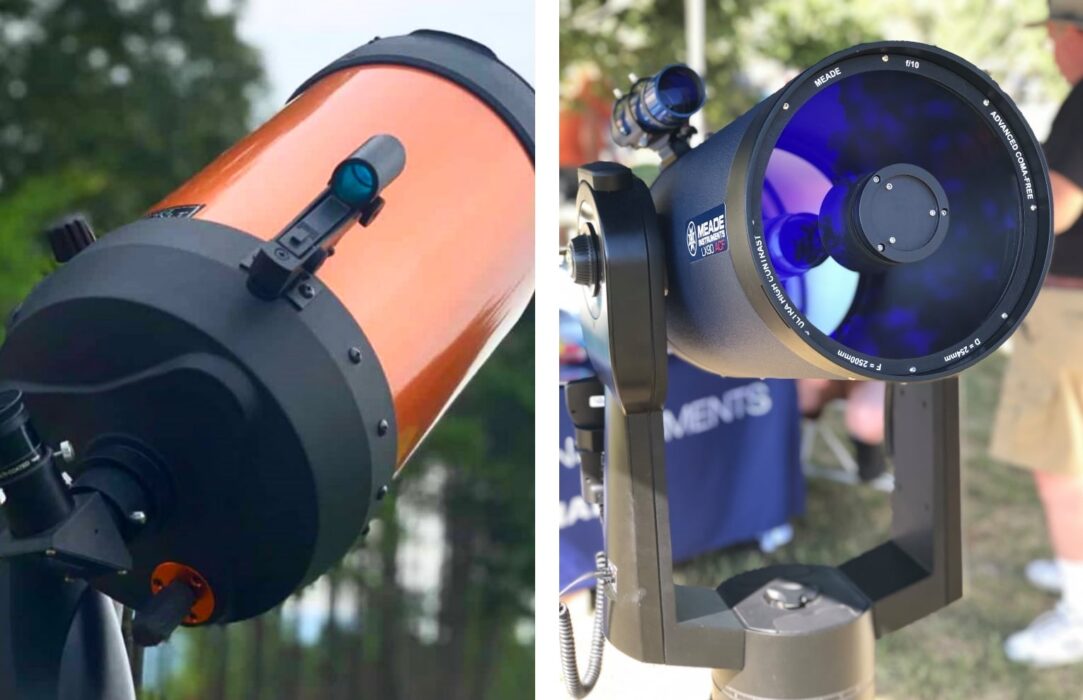
This accessory is aligned to create a wide field of view that enables you to find celestial objects that you then observe through your telescope.
Meade LX90 has an 8×50 optical viewfinder. Instead of an optical finder, Celestron 8SE features a red dot finder with 1x magnification that produces sky views right side up. Celestron 8SE has several mounting bracket holes that allow you to install an optical finder as well for higher magnification.
The objective lens size plays a role in the size and weight of a scope. This size is the same for the two Meade and Celestron models we are comparing, and their weight is also almost the same; only a difference of one pound.
As for the dimension of Meade LX90 vs Celestron 8SE, the former measures 14 x 47 x 21 inches and the latter which is smaller is 42.01 x 23.66 x 12.99 inches.
To further help you with identifying the best telescope to buy for your viewing needs, let’s review other Meade vs Celestron products that are rated highly by users.
These two models are equipped with powerful features that make them a great investment for advanced astronomers.
Celestron Advanced VX is designed to produce high-contrast views that are detailed. It works with GoTo to track moving sky objects. We recommend it for close observation of planets and the lunar surface which include maria and craters.
Meade LX850 features several qualities that make it a great investment for astrophotography, especially for deep-sky viewing; zero image-shift focusing, high-contrast imaging, a database of at least 144,000 celestial objects, computerized and GPS-enabled GoTo mount, and StarLocksystem for precise location of targets.
The focal ratio and length of Meade LX850 is f/8 and 2845 mm respectively whereas Celestron Advanced VX has f/10 focal ratio and 2350 mm focal length.
You calculate focal ratio, which refers to a telescope’s speed, by dividing the focal length by the aperture. For instance, if we divide the focal length of Celestron Advanced VX by its aperture of 235 mm, we get f/10 as the focal ratio. A larger focal ratio number results means the telescope will be slower, with less brightness, narrower field of view and higher magnification regardless of the eyepiece. Such models with f/11 or higher number are ideal for powerful photography and observation of binary stars and planets while the brightness and high-speed of telescopes with focal ratio of f/4 or f/5 favor deep space photography and observing objects in a wider field of view.
The two Meade and Celestron models for advanced users are in the medium category of focal ratio ranging from f/6 to f/10 which is versatile enough to be applied in most scenarios, including visual and astrophotography.
Meade LX850’s useful magnification ranges from 51x to 300x, and its highest theoretical magnification is 710x. The useful magnification in Celestron Advanced VX ranges from 34x to 555x.
Remember that the field of view narrows as you increase magnification.
We have already mentioned that the size of the objective lens imparts the amount of light transmitted and subsequently, the brightness and sharpness of the image. The reason Meade LX850 and Celestron Advanced VX are able to generate high-contrast images from a large distance is that they have large objective lenses. The objective lens diameter of Advanced VX is 9.25 inches, and LX850 has a larger 14-inch diameter. So, it has the more powerful objective lens whose capacity for brightness is an asset when viewing deep-sky and dim distant galaxies Trusted Source The universe is not as black as astronomers once thought. www.nytimes.com .
Despite its high-quality optics, Celestron Advanced VX is a compact and lightweight telescope that is 9.1 x 9.1 x 9.1 inches in size and weighs 30.8 pounds. That is excluding the mount and tripod which are bought separately. Meade LX850 weighs 63 pounds which is almost twice as much. It is also larger with dimensions of 32.3 x 20 x 15 inches. This is unsurprising since it also has a larger objective lens which adds to the overall size and weight.
If you need a basic telescope model that can help you dive into the world of astronomical discoveries, then the following models Meade LX65 vs Celestron 8SE may be a perfect fit for you.
Meade LX65 is a good choice for beginners because it is relatively affordable, easy to operate and quick to set up within 10 minutes. That is if you have already acquired a mount and tripod which are not included with the OTA. It is also light with a good aperture that allows you to carry it anywhere to observe the solar system. Celestron 8SE is another decent telescope for general observation or for an experienced visual observer. We recommend replacing the batteries with a lithium battery that won’t drain as fast for extended viewing.
Each of the two models is available with a library of at least 30,000 celestial objects which you will find useful in expanding your knowledge of astronomy.
Meade LX65 has focal length of 1524 mm, f/10 focal ratio and 152 mm aperture, and Celestron 8SE has focal length of 2032 mm, f/10.01 focal ratio, and a larger 203 mm aperture. Therefore, Celestron 8SE has a wider field of view and generates brighter images.
Celestron 8SE is available with a 25 mm eyepiece and 81.28x magnifying power. Meade LX65 comes with an eyepiece lens with diameter of 25 mm that is capable of 59x magnification. The relatively low magnification would be useful for wide field views that you can quickly align to navigate stars; views that would otherwise be affected by higher magnification.
When looking at the objective lens of these Meade vs Celestron telescopes for beginners, we see that Meade LX65 has objective lens diameter of 152 mm which is a smaller size compared to Celestron 8SE’s objective lens diameter of 203 mm. This is another aspect that proves that Celestron 8SE has the better optics, and that is why understandably costs significantly more.
As well as being the most budget-friendly telescope we have featured among the Meade vs Celestron products we have reviewed, Meade LX65 is also one of the most portable ones in our list. It weighs 9.14 pounds and measures 17.72 x 9.06 x 8.66 inches. Along with the steel tripod, Celestron 8SE dimensions are 42.01 x 23.66 x 12.99 inches and it weighs 33 pounds when assembled.
Regardless of your astronomy skills, you can find a suitable telescope that will serve your needs. When comparing between the two brands you must consider where and how you will be using the telescope because some of the features we have discussed in this review will be better suited for astrophotography as opposed to visual, and even then, the same features may work better on deep space objects while other features would be optimized when used for planetary imaging instead. This is why we went to great length to explain these key features and the role they play in performance and image quality in our review of Meade vs Celestron telescopes.

